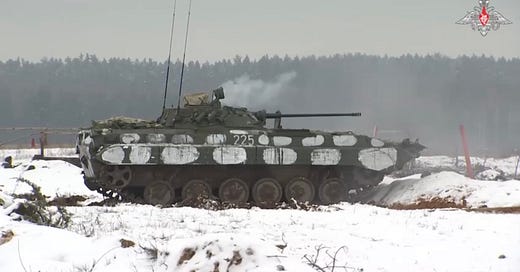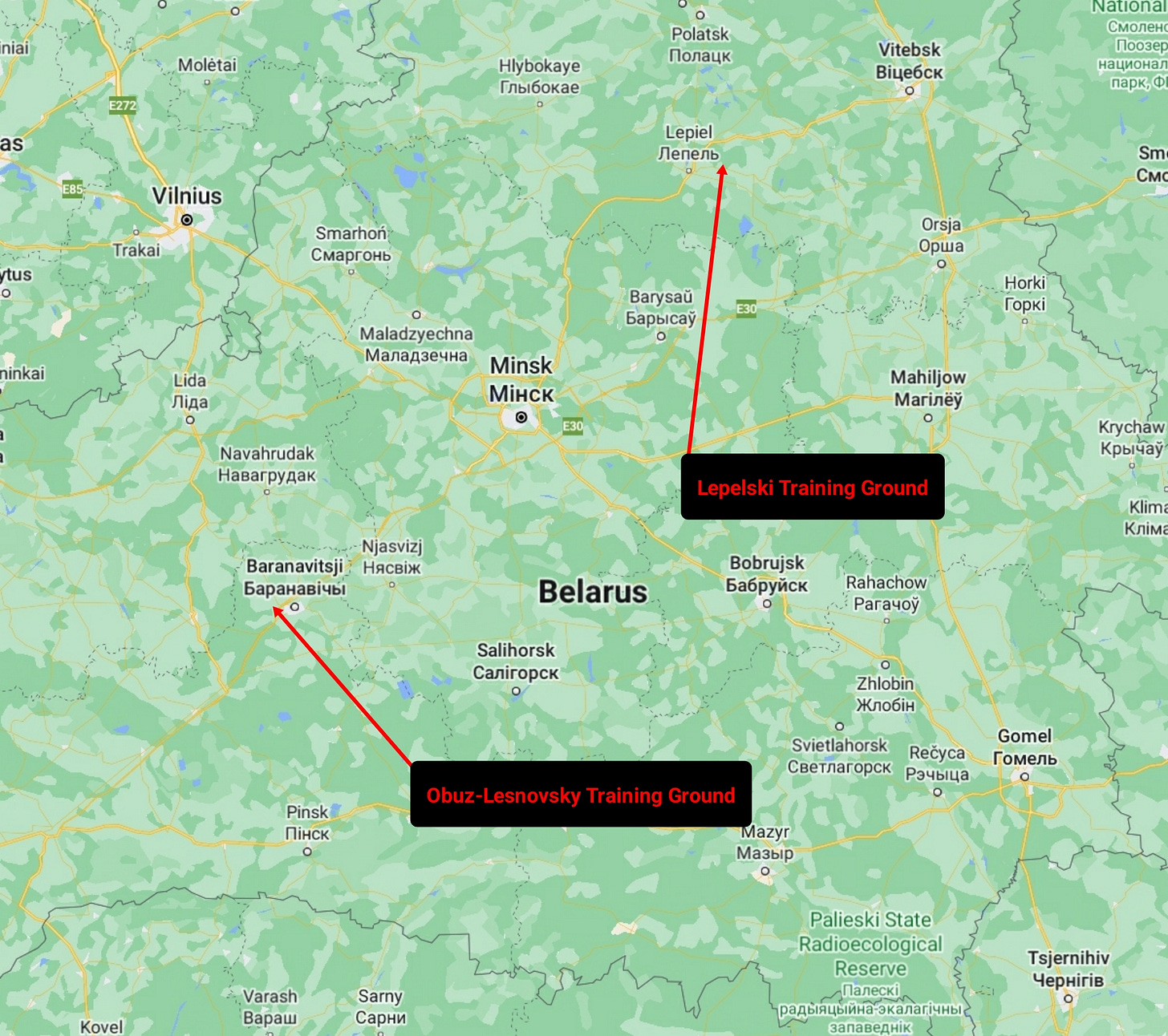Belarus and a new attack from the north?
Likely no imminent threat, but the future is more uncertain

2022 has seen an extraordinary level of military activity in Belarus. The ongoing readiness exercises, along with Russian mobilized personell training in the country, has sparked a debate about a possible renewed attack Ukraine from the north. Opinions, more or less well informed, vary from an imminent threat, to ruling it out as highly unlikely and therefore of no concern for Ukraine.


In the short term I find such an attack unlikely, but the direction things are moving, that may change over time, possibly as soon as January/February. In sum, I find that the developments in Belarus may point to something more than just tying down the Ukrainian units currently in place along the border.
Therefore the situation in Belarus warrants attention, and what happens there can influence the direction the war may take. The Ukrainian military leadership does take the threat seriously, and as shown below, they seem to anticipate an upcoming Russian offensive somewhere in early 2023.


I will not dive into Belarusian politics here, though they are a factor too, as I think when pressure mounts, Moscow likely has the final word, despite the obvious risks for the Minsk regime and Belarusian domestic stability.
Possible rationale
As I see it, the rationale behind a new offensive from Belarus, in one form or another and with or without Belarusian participation, is for Russia to try and regain the strategic initiative.
Russia has managed to stabilize the northern part of the active front, have withdraw across the Dnipro and are constructing extensive defensive lines. By opening a new front elsewhere, the Ukrainians will have to react, moving forces that could be used elsewhere. This may then prevent, or at least limit, any Ukrainian winter offensive(s).
To many this concept may sound stupid, unrealistic or far fetched, but Moscow may see it otherwise. Due to the potential consequences for Ukraine, I find it unwise to dismiss this idea based on such notions alone. Russia does what seems logical and rational in their eyes, which often differs from Western perception of the same questions.
The Belarusian Armed Forces and integration with Russia 1
In wartime, the Belarusian Armed Forces are intended to operate under the command of the Russian Western Military District. The ground forces and special forces under the Regional Group of Forces (RGF), the Air Force directly subordinated to the Western MD.
This again indicates the BAF’s very close cooperation with, or even subordination to, Russia’s armed forces: with no single overarching command, the ground forces do not conduct operational- and strategic-level exercises on their own; these are instead devised and planned in Moscow.
Therefore, Belarusian military activity, on the strategic and operational levels needs to be seen in conjunction with Russian plans and ambitions. Lukashenko has likely done his utmost so far to avoid direct participation, but there may come a time when he can't refuse anymore.
On October 10th, Lukashenko and Putin agreed to deploy/activate the Regional Group of Forces, citing the “worsening situation on the western borders of the Union State”2
Despite hectic exercise activity, which can be interpreted as war preparations, Belarus would likely have to mobilize in order to be ready for real operations. Despite many rumors and preparations for mobilization, it is likely this hasn't happened yet.
Also, due to the close integration with the Russian military, any Belarusian operations would likely be integrated with Russian operations, and the Russians highlylikely aren't ready for that yet.
Russian forces currently in Belarus
The current Russian ground forces deployment in Belarus looks mostly like training of mobilized personell. Their main concentration areas are the Obuz-Lesnovsky Training Ground, near Baranovichi, and the Lepelski Training Ground near Lepiel.
At the time of writing, the Russian forces in Belarus are likely too small to to represent an offensive threat, and they are located far from the border.
The Ukrainian Center for Defense Strategies reported in November that elements of the 1st Guards Tank Army would redeploy to Belarus, but their brief of December 13th places elements of the 2nd Guards MRD and 4th Guards TD in Bryansk Oblast. Other units of the 1st GTA are possibly still in northern Luhansk.3
If we are to see any major renewed offensive from Belarus, the core of the 1st echelon would likely be compromised of Russian units. A resuscitated 1st GTA is a good candidate for that role, but this would requiremajor movements, highly likely detectable through open sources.
The joker - The Russian mobilization
One factor that has potential to change the situation is the some 100 000 mobilized personell still training in Russia. It is presently not clear how this reserve will be used. Both replenishing existing units and creating new ones are possibilities. While the quality of these troops can be debated, it is foolhardy to dismiss them as irrelevant. Throwing mobilized units into the line did stabilize the front in northern Luhansk.
On new units, something called the Territorial Troops have been formed, with the highest formations identified being the 62nd and 63rd Motorized Rifle Divisions.4
These formations may have low combat capability, but the deployment of such units to border Oblasts in Russia could free up Western MD units for concentration elsewhere, possibly in Belarus. They can also be used for securing occupied territory as a 2nd echelon. Tracking how the Russians deploy their uncommitted reserves should be a priority in the weeks and months ahead.
Further down the line, new waves of mobilization is also likely, which along with the economic and industrial side of it, further complicates the long term picture.
According to a recent statement by CINC AFU General Valery Zaluzhny to the Economist5, "the Russian mobilization has worked." This stands in sharp contrast to the dismissals and ridicule often seen on Twitter when this subject is discussed.
Constraining factor - Availability of artillery ammunition
The determining factor in both sides offensive potential in this war is the availability of sufficient artillery ammunition. Russian expenditure has been heavy, and there are uncertainties concerning what Russia has available and what it can produce.
Belarus delivered some 65 000 tons of ammunition between March and September. How much this was of the total amount stored in the country, both for the Belarusian Armed Forces and in Russian prepositioned stocks is not known.


The question of artillery ammunition availability is very important, though hard to accurately ascertain, especially relying only on open sources.
Further discussion and summing up
Though a renewed attack from Belarus in the short term is unlikely, I have tried here to explain why I believe one shouldn't rule it out at the current stage, and come January/February or closer to the summer, things can look very different.
Belarusian entry into the war may have serious consequences for the country and Lukashenko's regime, but Moscow may consider that the lesser evil.
If events are heading this way, we will likely see a larger Russian grouping(s) being established, and this will likely be detected well in advance. Same goes for deployment from assembly areas to jump-off positions, both for Russian and Belarusian units. I have deliberately refrained from looking at detailed scenarios, as there are multiple options for future operations, and this is worthy of a study of its own.
The availability of artillery ammunition could severely restrict any Russian offensive operations, but the level of uncertainty is high, therefore this factor can't be used to rule out future operations either.
My fears may be unjustified and nothing reminiscent of what I have discussed may happen. However, due to the potential consequences, the possibility of a new attack from the north, and the possibility of direct Belarusian participation, needs to be taken seriously.
Regards
The Lookout
The Belarusian Armed Forces: Structures, Capabilities, and Defence Relations with Russia - Konrad Muzyka: https://icds.ee/wp-content/uploads/2021/08/The-Belarusian-Armed-Forces.pdf
https://eng.belta.by/president/view/lukashenko-putin-agree-on-deployment-of-joint-regional-group-of-forces-153704-2022/
https://defence.org.ua/dailybrief/2022-12-13/
https://defence.org.ua/dailybrief/2022-12-13/
https://www.economist.com/ukraines-fateful-winter



